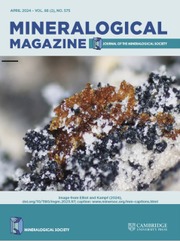David Green, ex Keeper of Mineralogy at Manchester Museum and former editor of the Russell Society, has joined Andy Tindle, to provide a second volume documenting the mineral diversity of Britain and Ireland. My first reaction on being asked to review this publication, was to query if there was enough new data to merit an updated volume? Well clearly yes! Time obviously has gone faster than one thinks, as the original volume was published in 2008. This update focusses on new data since then when Minerals of Britain and Ireland was published by Tindle.
The original volume described 1046 confirmed and 154 unconfirmed mineral species occurring in Britain and Ireland, in addition to providing details of groups, series, varieties and discredited species. It is heartening that since 2008, sufficient new data has been generated, to merit an update to this original work, which provides new entries for 159 species (13 of which are new to science) reported between 2009 and 2024, and flags up a further 80 species which are questionable and require additional study. In addition, there are updated entries for 589 species listed in Minerals of Britain and Ireland (MBI), which collectively reflects 20% of known IMA-approved species recorded in Britain and Ireland.
It will be of no surprise that a work by these two authors, maintains the high standard set by the original work (Fig. 1). It is clearly laid out, with the Introduction including a section on Conventions and Terminology so the reader is au fait with the format and abbreviations used. It also emphasises the importance of careful curation of specimens in private collections, to ensure provenance is preserved. The section on Recent Trends in Mineralogy outlines the rational for a printed volume, as opposed to a website, a factor of resources and funding and custodianship in perpetuity. It also outlines the state of public institutions with mineral collections with a diminishing mineralogical curatorial staff. Not to labour a point but this includes my own mineralogical and petrological team, whose contracts were terminated in 2024 by the Museum, including the prolific Tom Cotterrell, who has done much to progress Welsh topographic mineralogy. The section on Error and Uncertainty (with respect to identifications) provides interesting reading highlighting occurrences, although minor, of scientific fraud.

Figure 1. The new Edition of “MBI”. Available from info@russellsoc.org.
The heart of the work is the mineralogical entries. All are clearly coded to indicate the status of the mineral, namely, a confirmed IMA-approved species; IMA-approved species requiring further confirmation of occurrence; IMA-approved species which are no longer valid occurrences; and mineral names to be removed from the list, such as misspellings or are discredited IMA species. This is followed by a concise and informative entry for each species providing an outline of the mineral and its geological context. Details of new data since 2008 is then provided, grouped geographically by home nation. The information is authoritative and appears complete. The few instances where I thought something had been omitted, proved to be pre-2008 data and present in the last volume. Although the descriptions of occurrences supported by data sources are a valuable resource, it is no mean feat to have completed it; the great value in this work lies in that fact that it is not just a listing of documented species, but a critical review of this data to identify errors, mistakes, inconsistencies and fraudulent claims. Such evaluation is essential as unverified data so often continues to be quoted, if not take on a life of its own once in circulation, particularly through informal web content, and in informal text, where primary sources are not clearly cited. We have to accept that not all web data is of Mindat.org standards and rigour. This review of the mineral data reflects the knowledge, expertise and experience of the authors.
As with the MBI this volume is illustrated with excellent colour photography from a wide range of sources. Although image stacking software makes taking photomicrographs much easier, this is not to underplay the quality of these images. I direct you to those of a 2.2 mm synchysite-(Ce) from Blaenau Ffestiniog taken by John Chapmen (p 283). and the dendritic susannite from Cymystwyth mine, taken by Steve Rust (p282) as excellent examples.
The reference list is in itself is a fantastic resource, and this is followed by the appendix comprising a series of tables. These provide additional, and rapidly accessible, information on the species listed, such as those named after British or Irish citizens, British or Irish localities and species with British or Irish localities. Further tables list discredited species by the criteria listed above. A final section provides information on species not found in Britain or Ireland but with British or Irish connections, through the person they were named after. The final table lists all species present in this volume and also in MBI, again highlighting their status.
This volume, along with MBI, provides the definitive work on the mineral diversity of Britain and Ireland, and sets a gold standard for such works. In doing so it also provides a celebration of the many mineralogists, who have expanded mineralogical knowledge in the last 16 years. It reminds us that the mineralogical community is small, as is that of the museum mineral curators, so it is important that we bank knowledge whenever possible in an accessible form.
The authors should be congratulated on an excellent publication, which will stand the test of time. Also to be congratulated are the Russell Society who have sponsored this volume and whose members have contributed much data. In addition to being authoritative it is a book which can be enjoyed through casual browsing.


